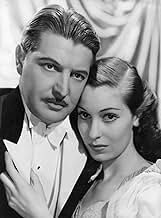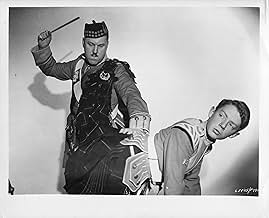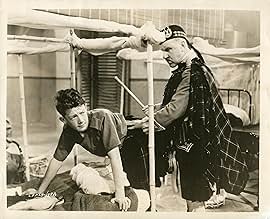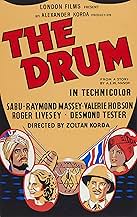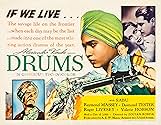IMDb-BEWERTUNG
6,3/10
997
IHRE BEWERTUNG
Füge eine Handlung in deiner Sprache hinzuIn British India, Captain Carruthers investigates arms smuggling on the North West Frontier. The governor makes peace with Tokot's ruler. Prince Azim bonds with Carruthers and learns drums f... Alles lesenIn British India, Captain Carruthers investigates arms smuggling on the North West Frontier. The governor makes peace with Tokot's ruler. Prince Azim bonds with Carruthers and learns drums from British boy Bill Holder.In British India, Captain Carruthers investigates arms smuggling on the North West Frontier. The governor makes peace with Tokot's ruler. Prince Azim bonds with Carruthers and learns drums from British boy Bill Holder.
- Auszeichnungen
- 1 Gewinn & 1 Nominierung insgesamt
Francis L. Sullivan
- Governor
- (as Francis L.Sullivan)
Laurence Baskcomb
- Zarullah
- (as Lawrence Baskcomb)
Julien Mitchell
- Sergeant
- (as Julian Mitchell)
Empfohlene Bewertungen
The British are trying to make peace treaties with numerous tribes in India to make sure there isn't an uprising among rebel tribes. Captain Carruthers makes a treaty with the prince, but when the prince's brother (Prince Ghul) murders the prince, he now has the tribes just where he wants him (in a spot to annihilate the British). The murdered prince's son (Prince Azul) reaches Carruthers and tells him of what happened, so Carruthers takes a troop to Ghul's fortress. Ghul welcomes Carruthers with a ceremony of a 5 day feast, but when the feast is over Ghul plans to kill all the British troops with their smuggled machine guns, unless Azim can lead a British battalion to Tokot to stop Ghul's mad plan. Despite being politically incorrect with the British superiority over the people of India, the film does contain a fair amount of action and thrills to entertain the film going audience, granted it is no Gunga Din or Four Feathers (the latter of which and this film share the same author). Massey oozes evil as Ghul, and their is decent support with Sabu, youthful as ever as Azim, Massey as the stuffed shirt Carruthers, and Hobson as his wife. The score is decent, but not that rousing and shooting in color limited the best chances to use lighting. Rating, 7.
A wicked Khan plans to use THE DRUM perched high up in his palace walls to signal the massacre of British soldiers invited to a banquet.
Sir Alexander Korda's London Films was responsible for this lively Technicolor action film which boasted outdoor scenes shot near the North-West Frontier with the assistance of the Mehtar of Chitral. It blends excitement, humor & history - definitely from a British viewpoint - into an attractive package sure to entertain the viewer lucky enough to find it.
Indian actor Sabu stars as the young Prince of Tokot who finds his life suddenly become very dangerous when he's forced to flee his usurping uncle and accept protection from the British Raj. Plummy-voiced Roger Livesey plays the Raj's stalwart envoy to Tokot who must find a way to stop the import of weapons to the evil new Khan, Raymond Massey, who is fomenting a rebellion. All three actors play their parts very well, with Massey especially attacking his villainous role with gusto.
Also in the cast are Valerie Hobson as Livesey's courageous wife; David Tree as a junior officer; and corpulent Francis L. Sullivan as the local Governor in Peshawar. Alfred Goddard appears unbilled as the hapless private Kelly.
*************************
Born Sabu Dastagir in 1924, Sabu was employed in the Maharaja of Mysore's stables when he was discovered by Korda's company and set before the cameras. His first four films (ELEPHANT BOY-1937, THE DRUM-1938, THE THIEF OF BAGDAD-1940, JUNGLE BOOK-1942) were his best and he found himself working out of Hollywood when they were completed. After distinguished military service in World War II he resumed his film career, but he became endlessly confined for years playing ethnic roles in undistinguished minor films, BLACK NARCISSUS (1947) being the one great exception. His final movie, Walt Disney's A TIGER WALKS (1964) was an improvement, but it was too late. Sabu had died of a heart attack in late 1963, only 39 years of age.
Sir Alexander Korda's London Films was responsible for this lively Technicolor action film which boasted outdoor scenes shot near the North-West Frontier with the assistance of the Mehtar of Chitral. It blends excitement, humor & history - definitely from a British viewpoint - into an attractive package sure to entertain the viewer lucky enough to find it.
Indian actor Sabu stars as the young Prince of Tokot who finds his life suddenly become very dangerous when he's forced to flee his usurping uncle and accept protection from the British Raj. Plummy-voiced Roger Livesey plays the Raj's stalwart envoy to Tokot who must find a way to stop the import of weapons to the evil new Khan, Raymond Massey, who is fomenting a rebellion. All three actors play their parts very well, with Massey especially attacking his villainous role with gusto.
Also in the cast are Valerie Hobson as Livesey's courageous wife; David Tree as a junior officer; and corpulent Francis L. Sullivan as the local Governor in Peshawar. Alfred Goddard appears unbilled as the hapless private Kelly.
*************************
Born Sabu Dastagir in 1924, Sabu was employed in the Maharaja of Mysore's stables when he was discovered by Korda's company and set before the cameras. His first four films (ELEPHANT BOY-1937, THE DRUM-1938, THE THIEF OF BAGDAD-1940, JUNGLE BOOK-1942) were his best and he found himself working out of Hollywood when they were completed. After distinguished military service in World War II he resumed his film career, but he became endlessly confined for years playing ethnic roles in undistinguished minor films, BLACK NARCISSUS (1947) being the one great exception. His final movie, Walt Disney's A TIGER WALKS (1964) was an improvement, but it was too late. Sabu had died of a heart attack in late 1963, only 39 years of age.
From 'Kim' to 'Carry On up the Khyber', from the famous to the infamous (stand up, Harry Flashman!), the North-West Frontier has proved a fertile source of conflict both fictional and historical... and deposed rulers and fiery mullahs have figured largely from that day to this. The plot of 'The Drum' cribs heavily (and at one point openly, with an impudently-inserted piece of dialogue listing the historical parallels that had been niggling at me!) from real-life events, especially in Afghanistan, and as other stories before and since have been based on the same material, this can result in a certain 'seen-it-all-before' sensation. But the winning element in this film is the touch of humanity and humour which helps the characters to become more than cardboard templates, from the drummer-boy and his misfortunes to the wry jests of the newly-appointed British representative walking open-eyed into a trap. Not to mention that, after a spate of films with seemingly pointless titles, I found it obscurely satisfying to encounter one where the eponymous instrument is actually significant both to the plot and its climax!
The always-excellent Sabu steals the film, as ever, in his role first as a self-possessed princeling and then as a fugitive in exile from his throne; the romantic leads, while well-performed, are less memorable. The tension in the banquet scene is tangible, and Raymond Massey as the usurper brings brains as well as menace to his role. The one element that rather shocked me -- with the exception of the inadvertent glimpse of buttock that reveals exactly what Scotsmen do or don't wear under their kilts! -- was the scene in which the said usurper is shot down by our wounded hero in cold blood, having thrown down his weapon. It's not customary for such an act to be depicted in an apparently approving manner; and certainly not in a film of this period...
I must admit that the question of the period itself had me slightly puzzled, although the mention of syncopation in the drum part for the dance should have given me a clue. I had automatically assumed the story to be set in nineteenth-century India in the heyday of the Raj rather than the contemporary world, and with few European civilian fashions on display, there was nothing to disabuse me of this until the heroine made an appearance in jodhpurs, which came as something of a shock! (And the subconscious resonance with the valleys of 'Carry On up the Khyber' turns out to be based in fact: locations from both were shot in Wales...)
But 'The Drum' is a rousing adventure as they used to make 'em, in the tradition of 'Charge of the Light Brigade' or 'Northwest Frontier'; if you like the genre, this one is a cracker.
The always-excellent Sabu steals the film, as ever, in his role first as a self-possessed princeling and then as a fugitive in exile from his throne; the romantic leads, while well-performed, are less memorable. The tension in the banquet scene is tangible, and Raymond Massey as the usurper brings brains as well as menace to his role. The one element that rather shocked me -- with the exception of the inadvertent glimpse of buttock that reveals exactly what Scotsmen do or don't wear under their kilts! -- was the scene in which the said usurper is shot down by our wounded hero in cold blood, having thrown down his weapon. It's not customary for such an act to be depicted in an apparently approving manner; and certainly not in a film of this period...
I must admit that the question of the period itself had me slightly puzzled, although the mention of syncopation in the drum part for the dance should have given me a clue. I had automatically assumed the story to be set in nineteenth-century India in the heyday of the Raj rather than the contemporary world, and with few European civilian fashions on display, there was nothing to disabuse me of this until the heroine made an appearance in jodhpurs, which came as something of a shock! (And the subconscious resonance with the valleys of 'Carry On up the Khyber' turns out to be based in fact: locations from both were shot in Wales...)
But 'The Drum' is a rousing adventure as they used to make 'em, in the tradition of 'Charge of the Light Brigade' or 'Northwest Frontier'; if you like the genre, this one is a cracker.
Exactly what you would expect from the era in which it was produced and given the man behind its production. A rip-roaring adventure yarn which attempts to convince its audience it is set in (then-)modern times, (with radio transmitters strapped onto to pack mules and attempts to slip in 'contemporary' songs, (of which more below)), but whose heart is really in the 1890s or thereabouts, extolling the virtues of British rule of the Raj, the comradeship formed across races by jointly facing adversity and evil plotters aiming to overthrow British rule - all wrapped up in a Kiplingnesque atmosphere and with LOTS of bagpipe music, highland dancing and marching ranks of soldiers. The acting/screen presence of Sabu and Roger Livesey are very good and commanding, as is also the case with Raymond Massey, (always watchable in any case), as the scheming 'baddie'. Val Hobson appears suitably 'fragant' and stiff-lipped in the lead female role, BUT whoever was responsible for the idea of getting her to mime to the 'contemporary' love song inserted in one of the dinner party scenes should certainly have been handed over to the insurgents for a VERY slow and agonising end! Conclusion: switch off the PC monitor, go back seventy years and just go with the flow of an entertainment movie which will zip by rapidly and leave you feeling you have spent 90 minutes in a care-free manner, (especially if you can hit the mute button when 'that song' comes on!)
In colonial India, the natives live happily and peacefully under the kind rule of their British masters. Representing the bond between the two nations, young Prince Azim befriends several of the British officers. However his uncle Ghul is less welcoming of the British and has dark plans to slaughter them and raise a rebellion among the tribes of the hills.
Some critics have pointed to the fact that, if this film were made today, it work spark outrage and be roundly condemned. This view ignores that, when the film was first screened in India in the late 30's, it sparked riots among the populace. However, the statement is true as well as being null and void, for there is zero danger of this film ever being made now! The plot is very pro-Empire and it is brazenly flag waving for the British. Looking back now, the film is laughable in it's depiction of it's characters. The British are kind and loving to all the Indians they encounter, while the Indians love them in return; those that don't are, of course, shifty and untrustworthy.
This is rather insulting if you think about it too much - I must admit I wasn't offended but then I am neither English or Indian and know little of the history that is clearly being twisted here in favour of propaganda. The film does have a nice vein of good humour to it though that prevents it being too heavy, while the battle scenes are of the `up'n'over' school of filming. The plot itself is too simplistic and can't keep the charade up - especially now that it will be clear to most viewers that it isn't a fair telling.
The cast are good, but again, there's no way that an `Indian' film would be shot today in Wales with the majority of the cast in blackface! The standout actor is Sabu. True his character is a little too good to be true but he has cheeky attitude and he is good fun throughout - just a shame his character seem to vanish for about a quarter of the film. The villainous Massey is also good fun and I enjoyed his performance. The British (namely Livesey and Hobson) are very stiff, although they do get the more heroic roles towards the end.
Overall this film is worth seeing as we will hopefully not see quite it's like again. The film is un-PC in casting, script, plot and characters, while the history it claims to tell is nothing more than a flag waving exercise that rightly started angry riots in Indian when it was shown there. However it is worth seeing for the period, the glorious (for the time) Technicolor and an amusing and fun performance from Sabu.
Some critics have pointed to the fact that, if this film were made today, it work spark outrage and be roundly condemned. This view ignores that, when the film was first screened in India in the late 30's, it sparked riots among the populace. However, the statement is true as well as being null and void, for there is zero danger of this film ever being made now! The plot is very pro-Empire and it is brazenly flag waving for the British. Looking back now, the film is laughable in it's depiction of it's characters. The British are kind and loving to all the Indians they encounter, while the Indians love them in return; those that don't are, of course, shifty and untrustworthy.
This is rather insulting if you think about it too much - I must admit I wasn't offended but then I am neither English or Indian and know little of the history that is clearly being twisted here in favour of propaganda. The film does have a nice vein of good humour to it though that prevents it being too heavy, while the battle scenes are of the `up'n'over' school of filming. The plot itself is too simplistic and can't keep the charade up - especially now that it will be clear to most viewers that it isn't a fair telling.
The cast are good, but again, there's no way that an `Indian' film would be shot today in Wales with the majority of the cast in blackface! The standout actor is Sabu. True his character is a little too good to be true but he has cheeky attitude and he is good fun throughout - just a shame his character seem to vanish for about a quarter of the film. The villainous Massey is also good fun and I enjoyed his performance. The British (namely Livesey and Hobson) are very stiff, although they do get the more heroic roles towards the end.
Overall this film is worth seeing as we will hopefully not see quite it's like again. The film is un-PC in casting, script, plot and characters, while the history it claims to tell is nothing more than a flag waving exercise that rightly started angry riots in Indian when it was shown there. However it is worth seeing for the period, the glorious (for the time) Technicolor and an amusing and fun performance from Sabu.
Wusstest du schon
- WissenswertesThe film caused protests when shown in Bombay and Madras, as it was considered by many to be British propaganda.
- Alternative VersionenVersion shown on Turner Classic Movies from "The Criterion Collection" runs 93 minutes
- VerbindungenFeatured in Family Classics: Family Classics: The Drum (1964)
Top-Auswahl
Melde dich zum Bewerten an und greife auf die Watchlist für personalisierte Empfehlungen zu.
- How long is The Drum?Powered by Alexa
Details
- Laufzeit
- 1 Std. 44 Min.(104 min)
- Seitenverhältnis
- 1.37 : 1
Zu dieser Seite beitragen
Bearbeitung vorschlagen oder fehlenden Inhalt hinzufügen

